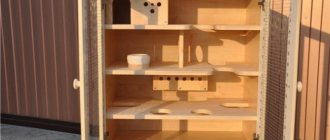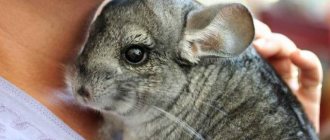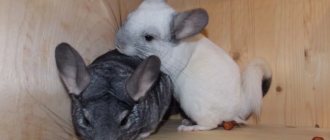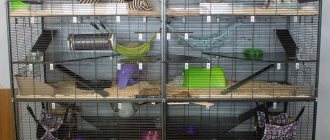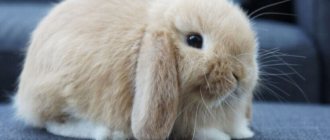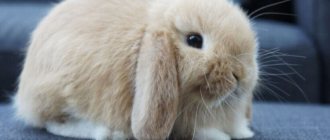Chinchillas, unlike many other animals, clean their fur of dirt not with water, but with the help of special sand. The fur of this rodent is characterized by increased density and thickness; it dries very slowly, so getting a chinchilla wet is only possible in the most extreme cases. Under natural conditions, the animal gets along well with sand, happily tumbling in it and cleaning its skin. At home, this pet also needs sand baths.
This item is necessary when keeping a chinchilla at home.
Why does a chinchilla need a swimsuit?
A special container filled with a small amount of fine, safe sand is called a bathing suit. This item is necessary when keeping a chinchilla at home.
This item allows the animal to clean its skin from almost any type of dirt, playing the role of a sand bath in which the pet can roll around to its heart's content. In addition to direct hygienic cleansing procedures, being in the sand brings a lot of joy to the rodent, so regularly providing the animal with a bathing suit with loose filler has a beneficial effect on the animal’s mood and well-being.
It is prohibited to bathe such an animal in water: the pet is very susceptible to drafts and can easily catch a cold. It is for this reason that it is undesirable to wet chinchilla fur with water, much less completely immerse the rodent itself in water. The water method of cleansing in this case is not natural for chinchillas.
Important. It is recommended to provide your pet with a container of sand no more than twice a week. At the same time, the time the animal spends in the sand should not exceed 30 minutes. Bathing for too long can dry out your skin and cause irritation.
How long have you had a chinchilla?
You should carefully consider the size of the swimsuit
How long after birth is swimming allowed?
After giving birth, a female chinchilla should not bathe for 1 - 1.5 weeks. This is due to the fact that her birth canal is not yet completely closed (accompanied by various mucous and bloody discharge). Therefore, many veterinarians agree that an animal can be in the sand after birth no earlier than a week later.
If a female rodent does not have any discharge after giving birth, you can give her the opportunity to lie in the sand for 3-4 days. And difficult (with complications) childbirth generally excludes chinchillas from bathing in the sand until complete recovery.
Did you like the article? Share with friends: [supsystic-social-sharing id=”1"]
- Related Posts
- Sennitsa for chinchilla
- The most popular toys for chinchillas
- What trees can chinchillas chew?
« Previous entry
Bathing suits for chinchillas: basic rules for choosing
Modern bathing suits for chinchillas can have different shapes, sizes and materials: the assortment of pet stores usually offers a huge number of different devices for washing this animal.
When choosing this item, the owner should first of all pay attention to the size of the bathing suit, as well as its safety: all edges and cuts of the container should be well processed and not have any sharp protrusions that could injure the animal.
Important. It is optimal to choose bathtub models with high edges so that the filler does not spill out. At the same time, the edges should not be too high: the pet needs to be provided with an easy and accessible entrance to the bathing suit.
Swimwear sizes
Any container intended for washing a rodent in this way must meet certain requirements. So, the volume of this item must be at least five liters, and the size must be sufficient for the pet to fit completely in the bath and be able to freely carry out the cleansing process.
The larger the size of such a container, the more comfortable the pet will be, and the less sand will spill out, making the cleaning process easier for the owner.
The average size of this product is about 35-45 cm in length, 15-20 cm in height and 30 cm in width. Smaller baths may restrict the animal's movements during washing.
Tips for choosing baths for chinchillas
You should choose such a thing very carefully, focusing not only on the size, but also on the model of the product itself: the swimsuit should be quite stable and durable, easy to wash and not have sharp protrusions or corners.
The entrance to the bathing container must be no smaller than the size of the animal, otherwise the pet may get stuck at the entrance or exit. At the same time, the entrance hole must be inspected especially carefully, making sure that the sides are well processed and completely safe. Models with rounded blunt sides are very good.
Reference. A bathing suit can be a separate full-fledged container in the form of a box, aquarium or container, where the animal is moved while performing hygiene procedures. In other cases, the bath is a small house that is placed directly in the animal’s home.
We consider ceramic to be the best option.
Reviews
Ekaterina, 36 years old: we decided to buy a plastic bathing suit for the chinchilla. They placed it on the bottom shelf in a display cage. There is also food and a scoop for pouring it into the feeder. A compartment was made in the structure itself so that the pet could jump down to the bathing suit. The animal quickly got used to the unusual object in the home. It is convenient to fill the bathing suit with volcanic sand. I liked that the container material is transparent. Thanks to this, you can watch the animal bathe in the sand.
Anastasia, 23 years old: we bathe chinchilla cubs in a special rectangular aquarium. It is high enough that rodents cannot get out of there. We buy volcanic sand at the nearest pet store. After reaching two months of age, we plan to accustom the animals to an adult bathing suit.
Bathing is one of the main procedures in the life of a chinchilla, without which the animal cannot remain healthy. Therefore, he needs to create comfortable conditions for the hygienic procedure. To do this, choose a spacious and safe product made of good material. But if you wish, it is possible to make a bathing suit for a chinchilla with your own hands. If you regularly take a bath, your pet will delight everyone with excellent health and a cheerful disposition.
The best material for swimwear
When choosing this item, the material from which the item is made is of great importance: the material must be non-toxic, durable and safe for the animal. Each material has a number of positive and negative features that are important for the rodent owner to consider.
Important. Sometimes you can find ready-made metal baths on sale, but they are considered the most impractical and inconvenient: such material is difficult to clean and scratches easily.
Glass
The glass product most often represents a separate container in which the animal is placed. This option allows you to observe the bathing process and easily remove your pet after completing the hygiene procedure.
Advantages:
- aesthetic appearance;
- glass is easy to clean and dries quickly;
- absence of sharp protrusions;
- does not absorb odors.
Flaws:
- sand can scratch the glass surface from the inside;
- an open top through which the animal can pour out the filler during washing.
Glass bathing suit looks aesthetically beautiful
Plastic
You can buy plastic baths at a pet store, make them yourself, or use existing household items as a rodent bath, for example, a small food storage container or a picnic container.
Advantages:
- availability;
- strength and durability;
- practicality - usually plastic bathing suits have a closed lid and a spacious entrance;
- ease of care for a platinum bathtub.
Flaws:
- A plastic container, as a rule, is quite light in weight, so the animal can turn it over.
Wooden
Wood is a natural material that a chinchilla will love: the pet can gnaw lightly on wooden baths, grinding down its teeth. In addition, the wooden product looks very original and presentable.
Pros:
- spectacular appearance;
- completely natural material;
- variety of models.
Minuses:
- fragility - wood can easily become unusable, especially when a pet tries to sharpen its teeth on such material;
- It is quite difficult to wash such a bathing suit;
- absorbs odors.
Ceramic
Many chinchilla owners prefer ceramic baths because of their practicality, beauty and safety. This item is easy to install in your pet’s house and easy to clean after bathing.
Pros:
- stability - ceramic bathing suits are quite heavy, so the animal will not turn them over;
- practicality - such a thing is easy to wash and dry;
- does not absorb odors;
- durability.
Minuses:
- sometimes there are models with an entrance that is too high, where it will be difficult for the pet to climb;
- the cost of such products can be quite high.
From plywood
Plywood options are good for their environmental friendliness and naturalness. In addition, you can easily make a plywood bath with your own hands.
Advantages:
- environmental friendliness;
- availability;
- original appearance.
Flaws:
- fragility;
- difficulty in cleaning the product;
- plywood can absorb unpleasant odors, which are very difficult to remove.
Reference . The best option for a pet chinchilla is a ceramic container, while the most affordable is a plastic or plywood container.
You can make a bathing suit with your own hands
Which sand to choose
In nature, chinchillas are washed using dust that was formed as a result of a volcanic eruption. Sand for bathing chinchillas is a very conventional name. It is more correct to use the term – filler. There is a large selection of this substance on sale with pricing ranging from 100 to 300 rubles. for 1 kg. (depending on production).
The following manufacturers have proven themselves best (in terms of price-quality ratio) in our market:
- Vitakraft,
- Little One,
- Mr. Alex and others
The use of ordinary sand to clean the animal's fur is contraindicated. A rough abrasive can harm your chinchilla's delicate skin. In addition, it can cause diseases associated with exposure to harmful bacteria, which swarm in large numbers in river (sea) sand. You should always take into account that in natural conditions, a chinchilla bathes in sterile volcanic ash and sedimentary rock products. They do not contain harmful bacteria and exclude any infection of the rodent.
In order to provide the most suitable conditions for a cute furry pet, manufacturers of litter, in which washing chinchillas will be most comfortable, decided not to abuse modern technologies. Famous manufacturers use only materials of natural origin. In addition, natural materials can eliminate unpleasant odors when bathing a chinchilla. This result can be obtained using sepiolite, ziolite, etc.
From the many offers it can be very difficult to choose just one. Although usually the composition of all fillers is identical, with a difference in the size of the grains of sand. Therefore, choosing the one in which the chinchilla’s bathing will be as comfortable as possible can only be done experimentally. The sand in which the animal “takes a bath” without enthusiasm should be replaced with another.
How to make a bathing suit for a chinchilla with your own hands
You can easily make a container for bathing your pet with your own hands. For this you can use either plastic, plywood or wood. The simplest, fastest and easiest option is to make a plastic bath, which is installed in the rodent’s house during bathing.
Important. When washing plastic containers, it is recommended to use only clean, warm water, avoiding the use of strong chemicals.
Tools and materials
- clean plastic bottle 5-10 liters;
- a sharp knife that can cut through plastic;
- sandpaper.
Manufacturing process
- Place the plastic bottle on its side, having previously covered the surface with a cloth. This is done to prevent the bottle from slipping;
- cut an even hole on the side of the bottle, making it slightly larger than the size of a chinchilla;
- process the cut with sandpaper, cleaning the edges.
Before use, the finished bathing suit with an open entrance through the ceiling should be rinsed once under running water, washing away any remaining plastic sawdust.
Where to place the cage
A chinchilla house should be installed in an apartment in a special place that meets the necessary conditions. So, it is imperative that there is no direct sunlight falling on the cell. The animal should always have the opportunity to rest in the shade. Don't forget, chinchillas are nocturnal animals and are awake at night. Therefore, bright sunlight will only disturb them.
Chinchillas must be protected from direct sunlight
You can place the cage not only on the surface of a bedside table or table. It's okay if you install it on the floor. It is best to place your pet's home inside the living room where your whole family gathers, so that the animal does not have to get bored alone.
Additional cage accessories
How to arrange a cage and what to place inside depends on the size. The larger the cell, the better. A large area will not only allow you to organize the space in an interesting way, but will also leave room for games and active movement. List of additional accessories:
When choosing an accessory for a cage, it is worth remembering that it must be safe. If the product is made of fabric, it is better to give preference to natural and undyed fabric. If it is made of wood, specify what type of wood was used. Some wood contains hazardous substances and can lead to poisoning.
Homemade accessories
They equip the cage not only with purchased goods. Some items can be made with your own hands. Most often, various shelves and ladders are made at home. Any pieces of plywood that can be attached to the walls of the cage using self-tapping screws or wire will be suitable as shelves. The number of shelves depends only on the height of the cage.
The ladder is both a delicacy and a game element. Usually it is made from twigs of different thicknesses, using the type of wood that rodents love: willow, birch, cherry, poplar, rowan. It is better to work with already dry twigs. If finding sufficiently dry wood is a problem in the summer, the pieces can be dried in the oven.
The branches must be divided: the long ones will go on the shelves, and the short ones (two centimeters each) will go on the crossbars. A hole two or three millimeters thick is drilled in the center of each crossbar. Similar holes are drilled in the shelves; about two centimeters must be removed from the edges. It is better to fasten the ladder links using wire. The end of the wire is inserted into the first shelf and a crossbar is strung on it. Secure it to the second shelf using a loop. Everything is repeated with each new shelf. The length of the finished ladder depends on the size of the cage.
Ideal home
The animal is very mobile, so they need a lot of space. When choosing a cage, first of all, be guided by its size. The minimum cage size for one animal is 50*50*70 (length*width*height). It is optimal to choose a more spacious home - 60*50*100.
The higher the cage, the better! Chinchillas love to jump and climb on bars. The cage must have at least 2 shelves.
You can also equip a storefront, since such a house has several advantages. It has closed walls, so dirt will not fly out. In addition, the showcase looks more stylish and can be successfully integrated into the interior.
Unfortunately, display cases are not sold in pet stores. You can order them from craftsmen or make them yourself. You can use wooden shelves or an old chest of drawers as a basis.
Accessories
Chinchillas definitely need:
- feeder;
- drinking bowl;
- house;
- stone for teeth point;
- manhole;
- stones and branches.
When your home is ready, start arranging it. First, she needs a water bowl and feeder. It is better to choose hanging options, so the animal will always have clean food and water. It is advisable to purchase metal utensils, as the wood will quickly wear down.
Be sure to put a house in the cage. It would be better if it were made of wood. Of course, sooner or later it will be eaten, but the animals will get great pleasure from such a shelter.
You can distract the animal from the point of its teeth on the cage or house using a special chalk stone. A teeth pointing stone can be purchased at any pet store and hung on the bars of the cage.
Large stones and branches of permitted trees can be placed in the cage (see section Feeding). The chinchilla will be pleased with the system of manholes and pipes where it can hide. If the size of the cage allows, hang a hammock in it. You can buy a hammock for ferrets or sew one yourself from thick fabric.
Toys
To prevent your fidget from getting bored, place several toys in the cage. Don't be discouraged if your upgrades don't make much of an impact. Chinchillas are completely unpredictable. They may be happy with an ordinary branch and not react at all to a new hole or house.
The best toys for chinchillas are wooden blocks and walnut shells. Watch how enthusiastically she drags them around the cage and gnaws them.
Standard running wheels for hamsters and guinea pigs have too large distances between the bars. While running fast, an animal can easily damage its paw. There are solid wheels made of wood, they are difficult to find, but they will suit the shushi well. If you are afraid that your pet is not getting enough activity, equip the cage with pipes and hang a few extra shelves.
Selection of combs
When choosing a comb for a chinchilla, it is important to remember that an ordinary comb used by people for daily toileting, as well as brushes for dog hair, will not suit the animal. Experts confirm that some models of combs for cats may be useful for combing, however, the most successful option for solving the problem would be to purchase a special device for rodents
Experts confirm that some models of combs for cats can be useful for combing, however, the most successful option for solving the problem would be to purchase a special device for rodents.
Chinchillas have soft and very thick fur, since one hair follicle can produce about 80 hairs.
That is why the main signs that you need to pay attention to when choosing a comb for a rodent are:
- the ability to freely penetrate the animal’s “hair”;
- long and thin teeth;
- lack of qualities of a “slicker”, which causes unpleasant sensations to the rodent due to the removal of not only fallen hairs, but also rooted hairs;
- blunt teeth that do not harm the skin.
Why doesn't the animal drink from the drinking bowl?
Chinchillas, despite their natural mobility, do not have a special love for water. They drink rarely and little, often the decrease in water during the day is unnoticeable.
However, it is always necessary to have access to water in the cage/enclosure. To completely refuse to drink, an animal needs a good reason. The reason may be:
- Water contamination, staleness, foreign unpleasant taste.
- Unaccustomed. Chinchillas sometimes get used to lapping from a bowl or using one type of sippy cup, and when the drinking structure changes, the rodent simply does not understand what it is and how to use it.
To correct the situation, you can change the water in the bottle or the drinking bowl itself. Well, or you can try to accustom the chinchilla to a new design.
What is a sennik and its purpose
You can often hear the second name for the hay barn – nursery. The hay box is a very convenient device, or rather, a second feeder for grass and hay. Fresh grass must be included in the animal's diet.
Decorative rabbits tend to scatter food throughout the cage, but nurseries prevent this. Animals can only get the required amount of food, but nothing more. That is, the hay forest ensures purity and economical feed consumption. The animals do not choose the most delicious grass, but eat the one that is closest. This function of the sennik prevents premature spoilage of products.
If there are several individuals in a cage, then such a device is especially useful in terms of keeping animals, since the rabbits will not be able to compete for food, and everyone will receive an equal share. It would be wise to place the manger above the tray, because rabbits on the run defecate directly while consuming food. This will help maintain hygiene.
If necessary, you can fill the second feeder with more hay or grass. Then you won’t have to frequently replenish food supplies.
Methods for installing a wheel in a cage
There are two ways to install running toys in a cage. The wooden structure can be secured to a wooden plank or plank using one or two self-tapping screws and placed on the floor of the cage. The disadvantage of this installation method is that if the board is too narrow, the animal will easily turn over its simulator. On average, the bar should be 10-15 cm wide.
The second installation method involves a tensioner screwed onto the bar. The structure is secured with wire to the cage wall. This option is more convenient, because The running wheel for a chinchilla is attached more securely and even very active rodents cannot turn it over or move it.
When buying a pet for your home, remember that caring for the pet and its health is your responsibility. A happy animal will become a great friend for your family members.
Other interesting ideas
If you don’t want to spend money or don’t have extra finances, then this option will be your salvation for the short term. You can simply take the box and place it next to the tray, first shortening it a little. If your pet damages the cardboard a little, you can simply replace the feeder with an alternative box.
An equally interesting way would be to adapt a household basket for a feeder. The first thing you will need to do is cut two holes. Through one the rabbit will receive food, and through the other the owner will supply it. All dimensions must be calculated individually according to your room
It is important to make sure that the rabbit cannot crawl into the hole and does not injure itself.
A plastic bucket can be used in the same way. Before using this method, it is worth thoroughly rinsing the container so that no odors scare the animal away from the improvised feeder. The lid will serve as a limiter to prevent the rabbit from eating everything at once.
But it is worth noting that a rabbit can chew the bucket and get poisoned, so you should watch it with special attention
The most unusual option is the package holder. It is secured with a wire in the desired position and place. Such a device can be found in a store, its price does not exceed 300 rubles.
For information on how to make a hay barn for rabbits, see below.
Don't be afraid to set up your rodent's cage yourself
As you can see, making a drinking bowl is not difficult; you don’t need any special tools or skills to do the job. Don't stop there - create other items the animal needs. For example, you can make a wide variety of toys for your hamster with your own hands: hanging bridges made of wood, dolls made of fabric, halves of walnut shells strung on a rope to grind down the claws and maintain a healthy lifestyle.
Don’t be afraid to show your own imagination and get creative, creating things that will decorate your hamster’s life and allow you to take care of the animal.
Recommendations for pet owners
This is especially true when choosing a place for new furniture in a cage. Poor placement of an animal's hanging bed can injure it or render it unusable.
There are several recommendations. Owners of animals who made a hammock with their own hands need to:
- Place new furniture on the second tier of the cage. In such a place, the new accessory will be less susceptible to contamination by litter and food particles.
- Hang the accessory at a height convenient for the hamster. This is necessary so that the pet does not get injured when climbing onto the bed.
- Observe the behavior of the animal. If he chews new furniture in the cage, it should be removed.
Periodically, the hanging bed will have to be washed. The made bed quickly becomes contaminated with debris brought in by the pet on its paws.
Types of hay fields
Hay feeders are available in three variations:
A variety of hay for rabbits
They differ in their location relative to the cell. The first ones are attached inside it, and the second ones - on the outside. External hay boxes are used when the pet's cage is small. In order not to clutter the space, the nursery is installed outside, on a grid. In this case, the rabbits can easily take the hay when they want to eat, right through the bars.
V-shaped mangers can be used for double cages; they are installed in the wall between them, so that neighboring rabbits have the opportunity to feast on hay at the same time from the same feeder.
